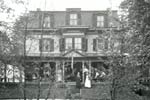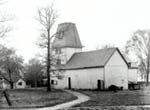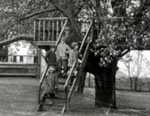
Bannerman Castle Slide Show and Lecture, June 13, 2001

Bannerman Castle Slide Show and Lecture, June 13, 2001
 Louise Meyer, a resident of Marrs Nursing Home in Mohegan Lake (now Tree Tops
Nursing Home), from May through October of 1989, wrote of her early memories of
Mohegan Lake and Incarnation Camp for the Marrs Newsletter that fall. Following
is a brief history of the camp excerpted from their Centennial Brochure “Memories
Of A Century”, along with Ms. Meyer’s account of her experiences there as a
child. This feature is an ongoing effort on the part of the Yorktown Historical
Society to share the personal accounts of events that shaped the lives of
Yorktown residents.
Louise Meyer, a resident of Marrs Nursing Home in Mohegan Lake (now Tree Tops
Nursing Home), from May through October of 1989, wrote of her early memories of
Mohegan Lake and Incarnation Camp for the Marrs Newsletter that fall. Following
is a brief history of the camp excerpted from their Centennial Brochure “Memories
Of A Century”, along with Ms. Meyer’s account of her experiences there as a
child. This feature is an ongoing effort on the part of the Yorktown Historical
Society to share the personal accounts of events that shaped the lives of
Yorktown residents.
 In 1886, the Episcopal Church of the Incarnation, located on Madison Ave. and
35th Street, NYC, rented a farmhouse in Mohegan Lake from R. Horne as part
of a “fresh air” program sponsored by the New York Tribune. Children from
the tenements of New York’s lower East Side, many of whom immigrated here from
Europe with their families during the 1880’s,
In 1886, the Episcopal Church of the Incarnation, located on Madison Ave. and
35th Street, NYC, rented a farmhouse in Mohegan Lake from R. Horne as part
of a “fresh air” program sponsored by the New York Tribune. Children from
the tenements of New York’s lower East Side, many of whom immigrated here from
Europe with their families during the 1880’s,  were taken from often squalid
living conditions to spend a week in the fresh country air of upstate New York.
The Rev. Arthur Brooks of Incarnation persuaded his parishioners to rent the
furnished farmhouse, and on June 19, 1886 25 young boys and girls from the east
side of Manhattan became the first campers. Each summer, some 230 children
benefited from the experience.
were taken from often squalid
living conditions to spend a week in the fresh country air of upstate New York.
The Rev. Arthur Brooks of Incarnation persuaded his parishioners to rent the
furnished farmhouse, and on June 19, 1886 25 young boys and girls from the east
side of Manhattan became the first campers. Each summer, some 230 children
benefited from the experience.
 Eight years later, in 1894, Incarnation parish raised $7000 for the purchase
of the farmhouse, plus an adjacent barn and a total of five acres “to be used
for the purposes of a summer home for the poor of the parish.” Also that year,
a parishioner made a contribution to have a swimming pool installed, complete
with pumps that replenished it with water from Lake Mohegan, half a mile away. A
second home was built in 1895, called Brooks Cottage, which was used
specifically for the parish’s Bethlehem Day Nursery.
Eight years later, in 1894, Incarnation parish raised $7000 for the purchase
of the farmhouse, plus an adjacent barn and a total of five acres “to be used
for the purposes of a summer home for the poor of the parish.” Also that year,
a parishioner made a contribution to have a swimming pool installed, complete
with pumps that replenished it with water from Lake Mohegan, half a mile away. A
second home was built in 1895, called Brooks Cottage, which was used
specifically for the parish’s Bethlehem Day Nursery.
During the winter of 1906-07, Incarnation parish decided to experiment with using the facilities in other seasons for convalescent care. Between December 1906 and the following June, it cared for over 200 convalescents, both adults and children.
From the Marrs Newsletter, Fall 1989:
Louise Meyer …has some very pleasant memories of Mohegan Lake in the early 1920’s when she and her sisters and brothers attended a summer camp located here.
“My family had always lived on the lower East Side of New York City. Born in Germany in 1875, my father came to America in 1892, later followed by an older brother. Together they made their way to Chicago, where my uncle opened up a haberdashery shop. How successful the business was we never knew, but by the turn of the century my uncle became homesick and returned to Germany leaving my father in New York.
My mother was born in Slovakia (before the First Great War part of Austria -Hungary and afterwards Czechoslovakia). She came to the United States in 1895 and the two met and married in the early 1900’s. Like so many other immigrants from Europe they struggled to make a living and raise a family, both working, both having no opportunity to further educate themselves beyond learning English and receiving training in the various fields of employment they undertook.
It wasn’t until during the war years that mother came to Incarnation Chapel for assistance as the family began to grow. We were already six (four girls and two boys). The Chapel offered pre-school and after-school care to many children of poor families of the neighborhood, and this help was a blessing to my parents. However, it wasn’t until the 1920’s that some of us were old enough to go to the camp and/or the convalescent home in Mohegan Lake.
We recall the great anticipation of leaving the crowded city for the country each time. We met the escort from the Chapel in front of the big clock in New York’s Grand Central Station and boarded the train for Peekskill, watching en route the many city houses turn into wide country fields and woodlands along the way. In Peekskill we left the train and boarded a trolley car for Mohegan, stopping at a corner where there was a store called Horton and Horne, which was also the location of the town’s post office. From there we walked down a long dirt road past an open field where cows were grazing. At the end of the road was the back entrance to the camp property.
 During summer camp, tents occupied most of the forward area of the campground
and in the other seasons the convalescents lived in the farmhouse. I remember
well its large size and especially the pantry! The milk, delivered daily, always
had thick cream on the top of the tall cans (before homogenization was started).
The barn adjoining the house was used primarily for the storage of camp
equipment, costumes, toys and games, etc., even for such goodies as apples and
hickory nuts.
During summer camp, tents occupied most of the forward area of the campground
and in the other seasons the convalescents lived in the farmhouse. I remember
well its large size and especially the pantry! The milk, delivered daily, always
had thick cream on the top of the tall cans (before homogenization was started).
The barn adjoining the house was used primarily for the storage of camp
equipment, costumes, toys and games, etc., even for such goodies as apples and
hickory nuts.
 There was a big tree covered with a deck above, around which there
were songs sung in the evening accompanied by an organ.
There was a big tree covered with a deck above, around which there
were songs sung in the evening accompanied by an organ.  There were frequent
nature walks or hikes around the big or little “triangles” both of which led
back to the entrances to the camp grounds. We were always warned to keep away
from the stone walls where poison ivy thrived!”
There were frequent
nature walks or hikes around the big or little “triangles” both of which led
back to the entrances to the camp grounds. We were always warned to keep away
from the stone walls where poison ivy thrived!”
In 1924, a young seminary graduate, Rev. Nicholas Feringa, decided that the Lake Mohegan site area was becoming too populated to serve as a proper outdoor environment. It was moved that year to Long Island, but the farmhouse and land continued to be owned by the Church of the Incarnation as a Convalescent Home.
A 1930 map of the area shows the Convalescent Home and barns on 7 acres on Lexington Ave., now the site of Tree Tops Nursing Home. In addition, the church owned a 10.7 acre parcel directly between Lake Mohegan and Rt. 6. It was situated between the Mohegan Inn and the Mohegan Military Academy and contained a boathouse on the lake. It is believed the campsites were located here. This is now the site of Villas on the Lake.
Written by Linda L. Kiederer
Photos courtesy of the Town Clerk
The Yorktown Historical Society updates the home page with seasonally appropriate articles and information. Click here to read our past issues.